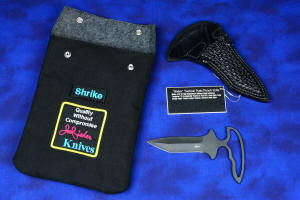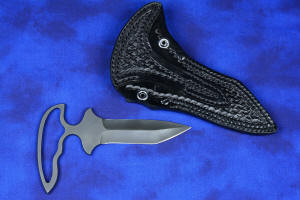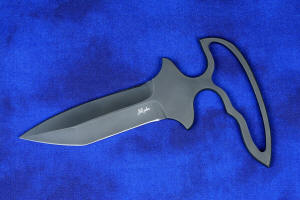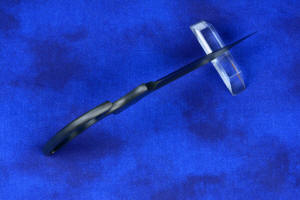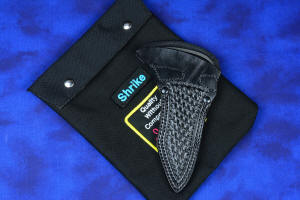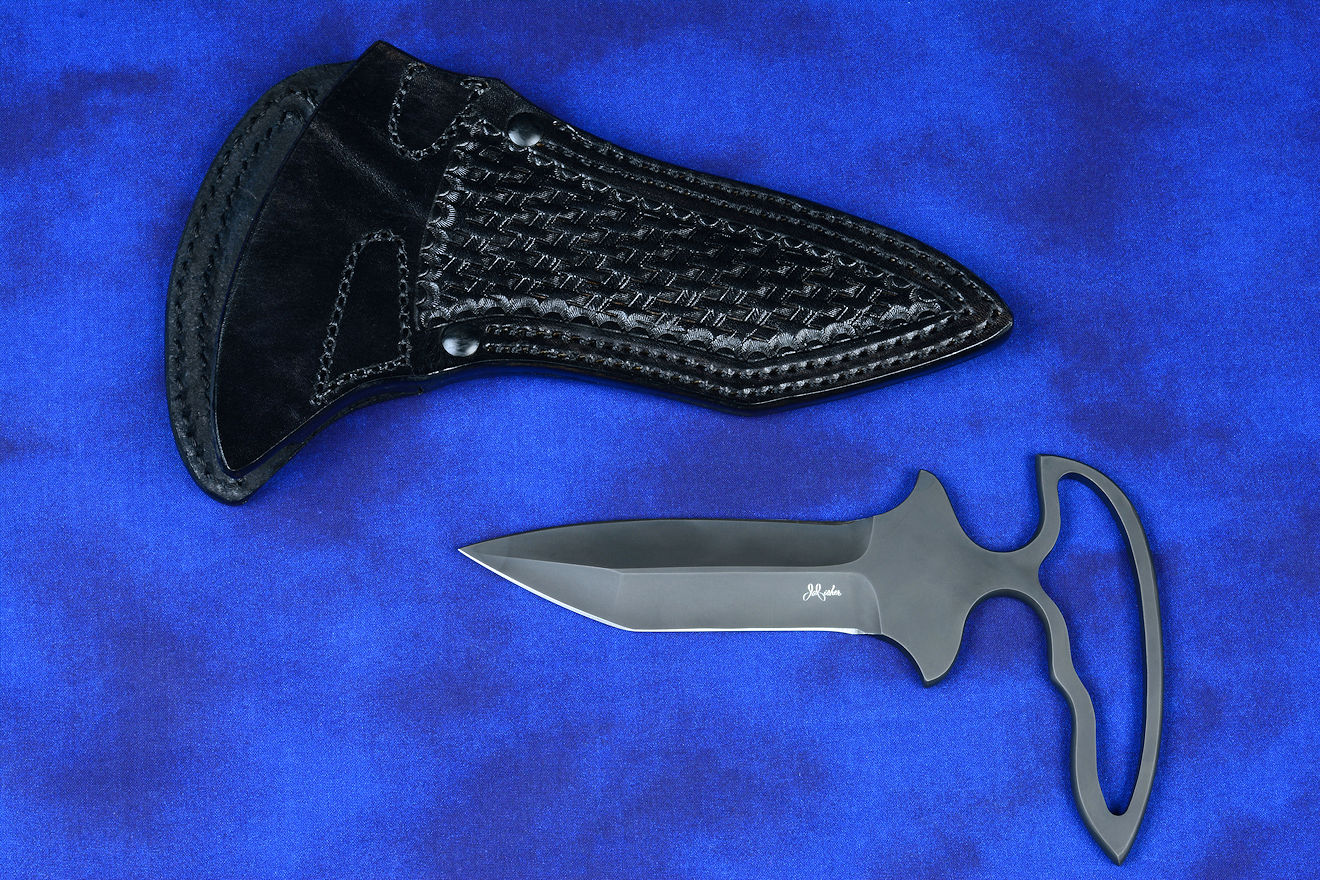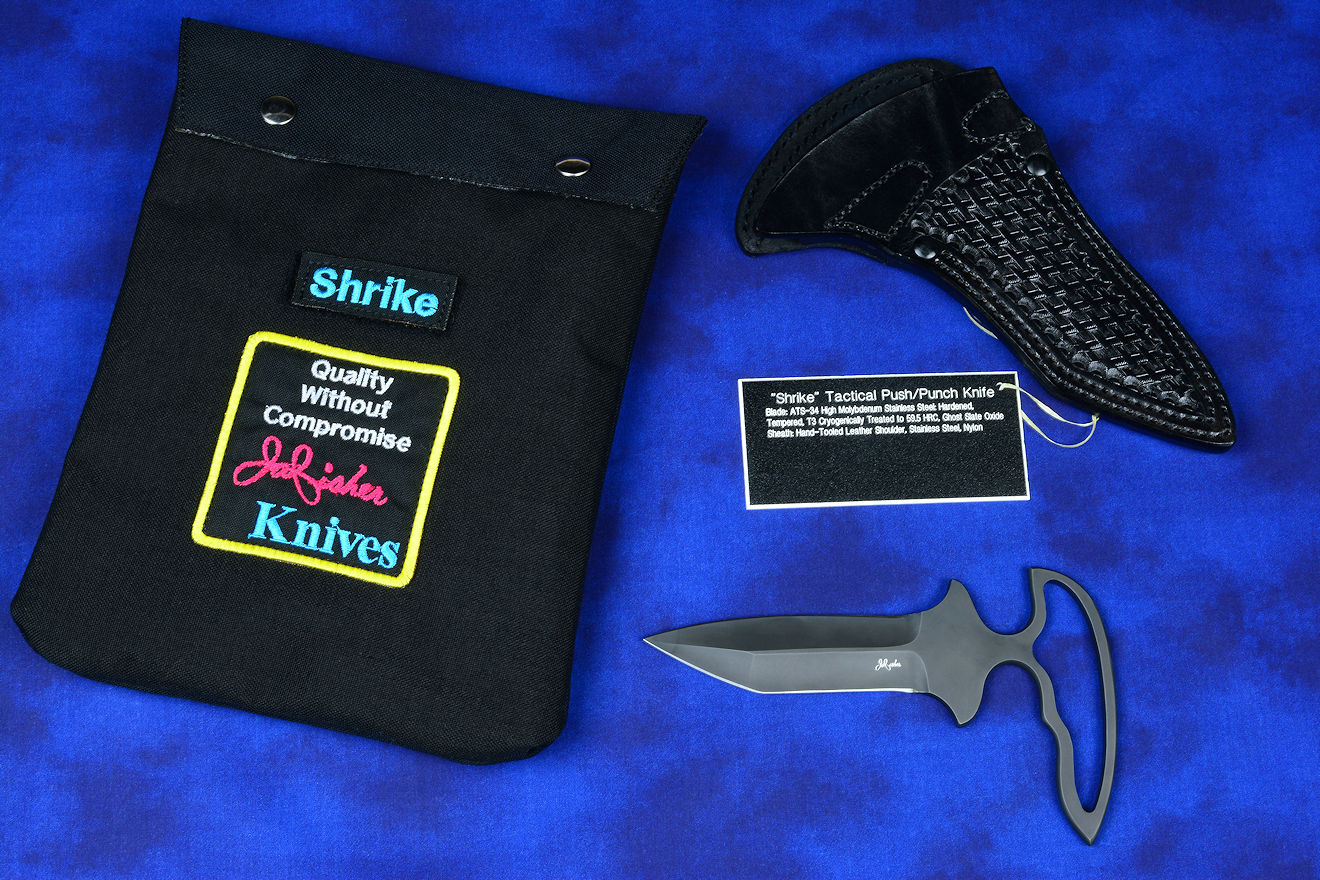"Shrike" Tactical, Utility Push, Punch Dagger/Knife
NOTICE!
I've made a new layout for the tactical knife descriptions, seen
on this page. I've separated the
components, briefly describing them in individual boxes. In those boxes
are links to dedicated pages describing everything about the part,
component, or accessory. The pages are substantial, and offer the
history, operation, materials, use, mounting, and care of each
accessory.
"Shrike" Tactical, Counterterrorism,
Push-Punch Dagger/Knife (Shadow Line)
With Post-Locking Heavy Leather Sheath
Designed for serious counterterrorism, PSD, and personal defensive use, this is a top-of-the-line,
extremely tough and corrosion-resistant knife and basic sheath.
NO OTHER SOURCE can supply what you see here, all finely handmade to
work when you most depend on it: safe when sheathed, lightweight and
ultimately useful when in hand.
Thanks, J. V.!
Included:
The Knife
- Size: Length overall max: 7.8" (19.8 cm), Width max at handle: 4.5" (11.4 cm), Blade Length at cutting edge: 4.5" (11.4 cm), Thickness: 0.250" (6.5 mm)
- Weight: 6.7 oz. (190 grams)
- Blade: ATS-34 High Molybdenum Martensitic Stainless Tool Steel, Hardened and Tempered, T3 Specialty Cryogenically treated to Rockwell C59.5, proprietary surface oxide treatment "Ghost Slate."
- Type/Purpose/Origin: Answering requests for an ultra
lightweight yet tough and wear-resistant push-punch dagger that
would function as a crossover between
tactical/counterterrorism/combat use and daily working and carry, I
designed my "Shrike" pattern. The name comes from a carnivorous
bird of the Laniidae family, which is Latin for "butcher." It's a
bird that wears a dark mask, and is also known as a "butcherbird,"
because of its aggressive feeding habits. It suited the knife
pattern well.
- Blade Steel Alloy: The Shrike blade is
made in ATS-34, a hypereutectoid, martensitic high
molybdenum stainless tool steel. In this steel, there are three significant
alloys that work together to make an extremely tough and
durable wear-resistant steel
with high corrosion resistance. First, there is
carbon, at 1.25 percent, allowing significant hardening and
forming of carbides. The second is chromium, and at 14
percent, it's a true stainless steel with high corrosion
resistance. The third and most effective is molybdenum.
ATS-34 has 4% of molybdenum, allowing a very high concentration of
molybdenum carbide particles, which are extremely wear-resistant
and contribute greatly to carbide formation at grain boundaries,
leading to overall stabilization of the microstructure and
leading to higher toughness overall. This means that
ATS-34, when properly treated, is highly resistant to breakage, even at a
high hardness. These three alloy elements combine to form very hard
vanadium carbides and chromium carbides, particles so hard that
typically diamond is preferred to sharpen this blade effectively.
- Heat Treatment: This Shrike has my T3
heat treatment, yielding an astounding blade in incredible
condition through advanced processing protocols. How advanced is
this treatment? It's a multi-stage cryogenic treatment,
involving temperatures ranging in over 2000°F (1090°C)
to -320°F (-196°C). The process is an evolution of my
advanced heat treating processes, and consists of 33 dedicated
and specific steps and takes 172 hours! This means that just to
heat treat this blade takes over a week! The reason for this is
scientific and critical, but yields the most stable, most
wear-resistant, most durable and long-lived structure of this
steel, profuse with fine multi-element carbides and a uniform
and unbelievably robust structure. The result is an incredibly tough, very hard,
very wear-resistant stainless steel. This is a testament to my
determination to make the very best knives, steels, treatments
and kits in the modern world. I know of no one else who has
advanced the treatment to this level; it's unheard of in the
metals and knifemaking field. This is, simply
put, ATS-34 at its very finest advanced condition.
- Blade Design and Geometry: I double-hollow-ground the
edges of this Shrike blade with a 3" contact wheel,
something few, if any, other makers do, simply because it's very
difficult to achieve. What this tight grind geometry produces is
a blade that is extremely thin at the cutting edge, yet
thick and substantial down the central spine, critical for
support of a double-edged knife blade. This is a double-edged
tanto design, so the secondary cutting apex of the tanto can be
used to bear down when cutting in utility chores, and the tanto
point is wide-angled and very strong, for the thin geometry. The blade has no choils to become
trapped or snagged in any clothing, gear, or object being
cut and the cutting edges simply taper to a stop in the grind for smoothness in
motion. The blade has substantial quillons that are
2.5" (6.4 cm) at the widest that serve four purposes: one is
to stop penetration of the blade at its limit, the second is to
protect the fingers from any metal, edges, or projections, the
third is to provide a smooth, rounded, contoured surface for the
fingers for maximum grip security, and the fourth is to engage
in the sheath retention method in the leather (described below). The blade is supported by a
1/4" thick and heavy central neck-ricasso to provide transfer of force from the
hand to the blade edges and point, and the handle tang is full
thickness in the palm for a solid, complete support.
- Blade Finish: The blade is finished in my flat,
dark "Shadow" line of
counterterrorism, rescue, and tactical knife finishes. Answering
the request for completely subdued and non-reflective
surfaces, I developed the Shadow Line with my Ghost
Slate finish. This means darkening in a permanent
fashion the stainless steel of the knife, with matching sheath. Read more about
my Shadow Line and Ghost Slate finish on my
Counterterrorism Knives page
at this bookmark.
- Handle: I milled the tang in a skeletonized
geometry, for ultimate weight reduction. The skeletonized handle
tang is the lightest possible, and all surfaces are rounded,
contoured, and smoothed for a comfortable, extremely lightweight
grip. This type of handle results in a knife that is fully half
of the weight of full tang punch daggers with handles. This
results in a thinner, lower flat profile when sheathed, as well. The
handle of the Shrike is designed with one of my "talon" palm
heel points, used in my popular "Guardian" and "Ari B'Lilah" models. The notable thing is that this
talon is comfortably concealed in the sheath, safe for the knife owner; he won't
encounter the point unless the knife is unsheathed.
- Balance and Feel: The balance
point of the knife is exactly at the quillons,
and the knife feels extremely lightweight, yet strong, molded to the hand when
gripped in the fist. By design, the fingertips engage the inside of the
handle milling for extra secure grip. This knife was conceived for the wearer to
be able to immediately put it in his hand, with the handle
shank between the first two fingers, in closed-fist form,
without an elaborate grip technique, and to use or defend his life with
simple punching and and thrusting motion natural to human
movement. No matter where the enemy is attacking, the blade will
yield an extremely aggressive point and razor-sharp cutting edge
with enough power behind it to drive through heavy clothing,
around gear and equipment with tremendous force. The tanto
design of the blade makes it a sure performer for daily carry
and work as well.
- This is an serious defensive and tactical weapon
for the most critical of counterterrorism and tactical close
quarters combat situations, while being a fully functional
daily carry useful utility tool.
Included:
The Sheath
The Positively Locking Leather Sheath
- Weight: 6.9 oz. (196 grams)
- Materials: 9-10 oz. Leather Shoulder, Nylon
high strength thread, stainless steel Chicago screws, stainless
steel dot snaps
- Description: I've created an advanced leather
sheath for this model, based on client feedback and necessity of
safety and strength for daily carry. My clients may typically wear a leather
sheath for daily carry, so I wanted to create a leather sheath that
was as close to indestructible as leather can be. I started with the
thickness; this is thick shoulder, about 0.2" (5 mm) thick, as heavy as
leather armor, and the heaviest leather straps for rigging, and
twice as thick as the leather on a saddle. I hand-stamped/tooled the
sheath in a bordered randomized design, and dyed it black. The first thing you'll notice
about the sheath is the very high front,
covering the knife blade and handle almost completely, protecting
the wearer from the persuader point. It also shields the knife
handle from view for privacy. On the sheath front are two "D" shaped tab
stitched points; these are the locations of the two D-shaped tab
retention points that engage specific locations on the knife handle.
These tabs have stainless steel (corrosion-proof and very strong)
dot snaps that snap to the inside sheath back. When the knife is in
the sheath, these dot snaps are engaged, making two audible and
tactile "snaps" that assure the wearer that the knife is secured.
When snapped, it's impossible for the knife to be removed, to fall,
to vibrate out, or to even be forced from the sheath. This makes
this design a positively-locking leather sheath that can't be forced, even in
the most violent and active situations. When the wearer wants to
remove the knife, he pushes his fingertips into the handle,
unsnapping and folding the front face of the sheath outward,
unsnapping the tabs, moving them out of engagement points on the knife handle. Because the front of the
sheath folds, it's made of extra-thick leather and it's reinforced
at that critical point with two 304 stainless steel Chicago screws,
which go completely through the sheath front, welts, and sheath back. This
way, no stress is on the stitching at this point. What about the
stitching? The belt loop I secured with double row stitching of
nylon, for great strength and durability. The belt loop
will accommodate a 2.0" wide belt. On the welts, back, and front, I
stitched the sheath with double-row stitches, for extreme strength,
stiffening, and durability. The sheath is rounded, contoured,
smoothed, and sealed with three coats of lacquer for longevity.
- Casual and PSD wear: Clearly, most of my
tactical and combat gear cannot be mistaken for utility wear. Heavy,
solid kydex sheaths can be bulky and weighty to wear in the casual
sense, nor are they meant to be. The Shrike sheath is different.
Because it's hand-tooled leather, more common daily and casual wear
is possible, traditionally on the belt. This makes the knife a good
choice for PSD (Principal Security Detail, or Security Detail) work.
- Simply put: This is the most secure, durable,
and well-constructed leather sheath possible.
Included:
Storage
- Envelope Bag: 1000 denier Cordura® ballistic
black nylon, waterproof polyurethane coated, inside layered in heavy
polyester felt. Stainless steel dot snaps, embroidered patch, removable
embroidered name patch with hook and loop
Please click on thumbnail knife photos of this Shrike!
